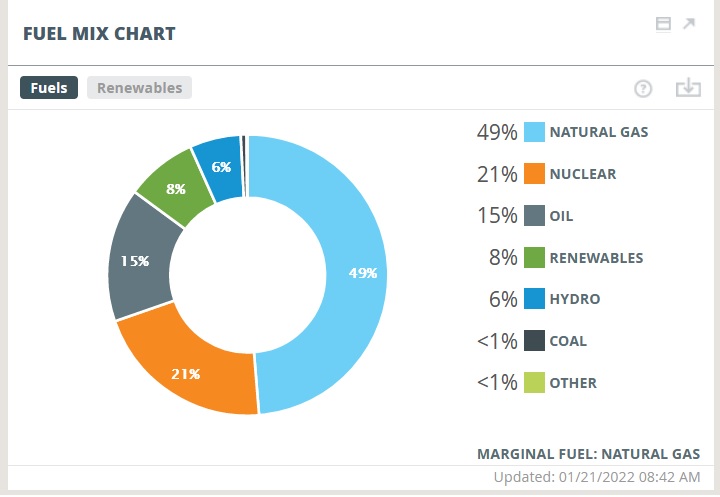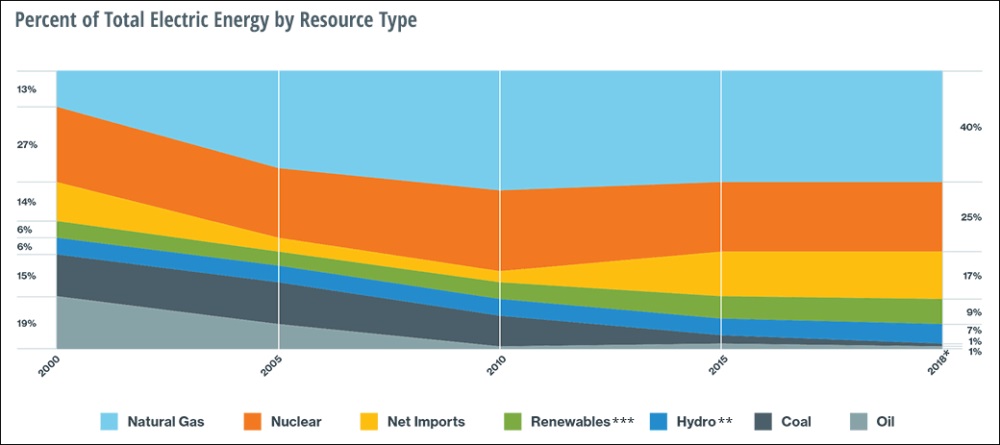For most of January, New England has been reliving a piece of our past. Unfortunately, it’s a smoggy, polluting piece.
During the recent cold snap, more than a tenth of the electricity generated in New England has been produced by power plants that are burning oil, something that hasn’t happened for at least 15 years.
Burning oil for electricity was standard practice throughout the region for decades. It was once our most common fuel for power and as recently as 2000, fully 19% of the six-state region’s electricity came from burning oil, according to ISO-New England, more than any other source except nuclear power.
Since then, however, natural gas has gotten so cheap that most oil-fired plants have been shut or converted to burn gas, to the point that just 1% of New England’s electricity came from oil in 2018, whereas about half our power came from natural gas. This is good because natural gas produces less pollution, both particulates and greenhouse gasses, although exactly how much less is a matter of debate.
But as you probably know, there’s a problem: Natural gas is also used for heating, which gets first dibs. Prolonged cold snaps require so much gas to keep us warm that there might not be enough for power plants – at least, not at prices they’re willing to pay.
After we came close to rolling brownouts during the polar vortex in the 2017-18 winter because gas-fired power plants cut back so much, ISO-NE, which has oversight of the power grid, established “winter reliability” rules. The most important change was to pay power plants to become dual-fuel, meaning they can switch quickly between natural gas and oil, and to stockpile oil for winter cold snaps.
We’re seeing that practice in action right now, as many dual-fuel plants have switched away from gas to oil, just as was intended.
That switch is part of the reason EPA says the region’s carbon emissions have gone up in the pandemic, from 22 million tons of CO2 in 2019 to 24 million tons in 2021. That reverses a long trend caused partly by closing of coal plants and partly by growing solar and wind: New England power generation produced 36 million tons of CO2 a decade ago.

So if we admit that a return to oil burning is bad, and it is, what can we do in future winters? There are many possibilities.
+ The most obvious solution is to import more natural gas, especially from fracked fields in New York state and Pennsylvania. But efforts to build pipelines to do that have been shot down a couple of times and seem unlikely to go forward and importing more gas via ocean tanker in the form of liquefied natural gas (LNG) is also an option, but hits limits in terms of port facilities.
Aside from NIMBY concerns, the problem with building pipelines or ports to import more gas is that pipelines and ports are very expensive. Once they’re built they create a financial incentive to keep using natural gas for decades to justify the expense. That makes it much harder for New England to decarbonize and potentially leaves ratepayers on the hook for a boatload of stranded costs.
+ We could produce more clean local power from solar and wind, and build a lot more energy storage (batteries, pumped hydropower) to cover slack periods. We could also use distributed energy such as rooftop solar or batteries in homes and electric cars to buffer parts of the grid from shortages.
This is happening – offshore wind will madke a huge difference once it (finally!) arrives – but not fast enough to give us much security in the next few winters.
+ We could import more electricity from outside the region, but that requires building large power lines, something that nobody seems to like. Or we could build another nuclear power plant! Yeah, that’s going to happen.
+ Then there’s the disruptive option: concentrate on demand rather than supply.
We could better control our need for electricity through efficiency measures as well as demand response, where users are paid to turn off devices or otherwise cut back during peak periods. Demand response exists for commercial and industrial customers and already is able to reduce regional electricity needs by more power than Seabrook Station produces, but really expanding it and making ourselves more efficient would take a sea change in the way we regulate and build the power grid.
This approach is cheap and clean, and while it’s not a magic bullet – you can’t have an economy without generating a lot of electricity – it gives us time as we clean up the grid with more wind and solar and it buffets our wallets from rising costs of fuels imported from outside region.
But this isn’t easy or straightforward because it involves policy and politics and regulations. Basically, we need to reinvent the 19th-century approach to electricity, taking a one-way electron pump between a few power plants and your house, turning it into a 21st century to-and-fro in which everybody has a say.
Judging from the way the Public Utilities Commission wants to dismantle New Hampshire’s already feeble efficiency efforts, this will be a tough slog. A hopeful sign is that the PUC action has drawn widespread condemnation with the sort of unanimity we rarely see from the legislature, so maybe the climate crisis and energy price swings and general feeling that the current system isn’t working as it should – maybe that will give us the guts and insight to redesign the system.
If not, we can expect a lot more burned oil to blacken our skies.



 Return to the Concord Monitor
Return to the Concord Monitor
Not mentioned in the article, but I do know when natural gas is converted to residential use, the grid will rely on the Bow NH coal station for backup.
I started to talk about coal but the article was getting too long anyway so I tossed it. There’s no reason we couldn’t depend on various storage and demand-response as “backup” but it’s easier to just pay the existing power plant, we already understand the tech and the financing.
Correct me if I’m wrong here, but dual fuel plants are just old school oil fired plants with added natural gas burners, right? Thus while flexible as to fuel, they lose the added 20% +/- efficiency of combined cycle gas plants, no?
I believe you are correct, at least in general, but this is out of my expertise.
I wanted to put another slant on this and say that New Hampshire is ahead of all other states in New England I producing carbon free electricity, second only to Vermont. We have Seabrook Nuclear Power plant to thank for that. I used data from Lawrence Livermore Laboratory at https://flowcharts.llnl.gov/commodities/energy where it shows that in 2019, New Hampshire electricity production was 73% carbon free (Vermont is over 99% carbon free). On the other hand, we get our electricity by pooling all generation through ISO-New England, which as a whole is only 26% from carbon free sources when totaled across all 6 New England states. Connecticut is only 53% carbon free, Rhode Island is 5% carbon free, and Massachusetts is 20% carbon free. In summary, we end up purchasing electricity that contains a mixture of a lot of high carbon sources from out of state, but we generate a lot of carbon free energy. We can do better to cut back on natural gas, biomass and coal.
Could it be that Vermont is 99% carbon free because they get over 30% of their electricity from Nuclear? Not Vermont Yankee but from Seabrook.
not sure about the 30% but they do import a lot
According to 2019 data shown on Sankey diagram for Vermont, production was:
1.3 solar
11.9 hydro
3.4 wind
0.9 other (mostly biomass)
17.5 subtotal produced in VT
1.0 Imported electricity
18.5 Total electricity consumed in VT
You are correct that when looking at consumption from ISO-NE and the grid, VT production is blended with the other New England states and many more electrons come from burning carbon based products. But, since each stat has some control over operating licenses, we can justifiably focus on where the fuel is burned and give credit where due. If you want to see what is supplying your electricity, go to the website below. Notice how demand ramped up at 5am and hydro came up sharply, along with natural gas. Also, notice how the marginal price jumped up.
Bill, I don’t see the link to the “website below”. Can you please (re)post?
Also, the 2019 chart I see for Vermont at https://flowcharts.llnl.gov/content/assets/images/charts/Energy/Energy_2019_United-States_VT.png has a larger value for biomass generation:
1.3 solar
11.9 hydro
3.4 wind
5.9 biomass
22.5 trillion BTUs generated in VT
Kirk, you are correct, the inputs to electrical generation are 5.9, however, the output from that is only 0.9 due to the losses in the power plant. The solar, wind, hydro come in as electricity, so show with no losses. In truth there are losses, however, it is hard to measure so we just see the output of the generation source.
Sorry, here are url’s
Sankey – at top pull down commodities then energy
https://flowcharts.llnl.gov/commodities/energy
ISO-NE
https://www.iso-ne.com/isoexpress/web/charts
Can you imagine the furor if the rumors got out that the government is supporting solar over oil?
We can have all these technical discussions and great ideas but we can’t do anything if we can’t change what people think.
I just listened to a guy telling me about how solar panels cause next door houses to catch fire, and how ancient oaks are cut down for solar farms. I told him my house is not on fire and my oaks are still standing, but I know it didn’t matter to him. Here we go.